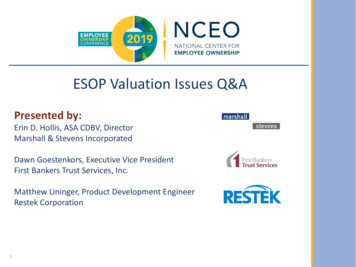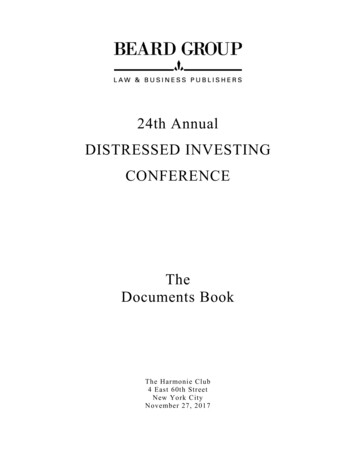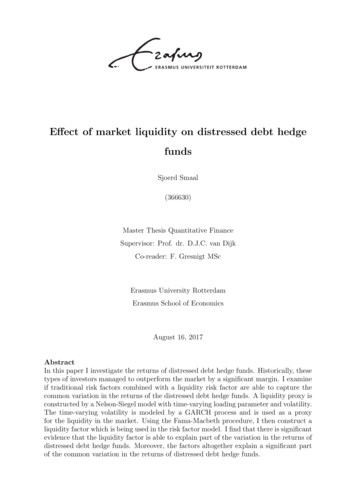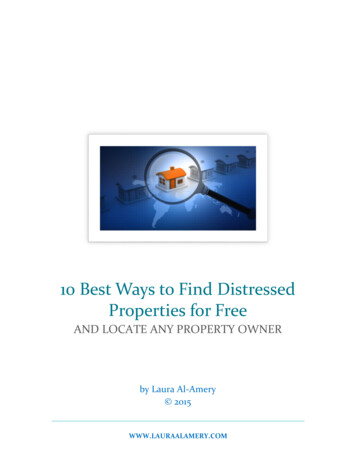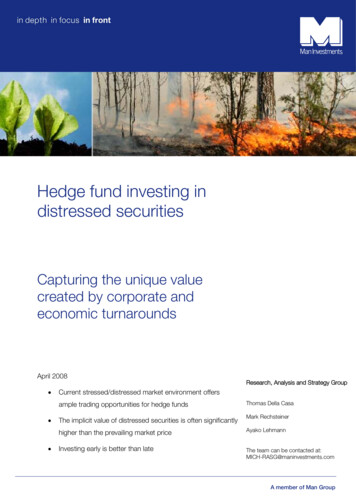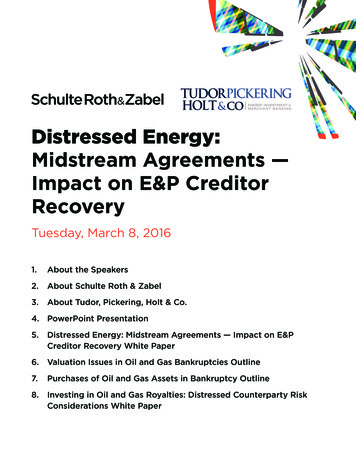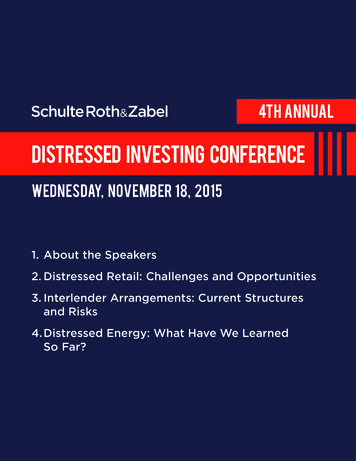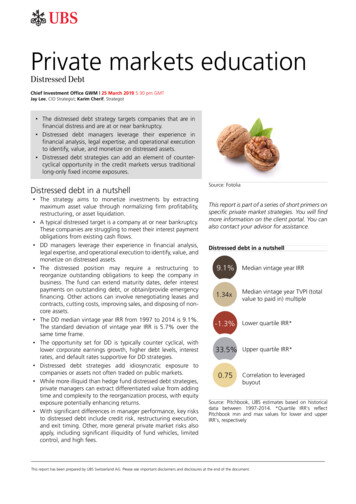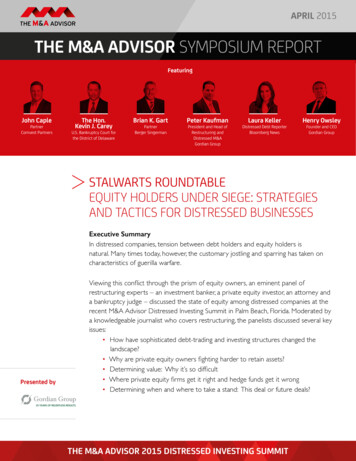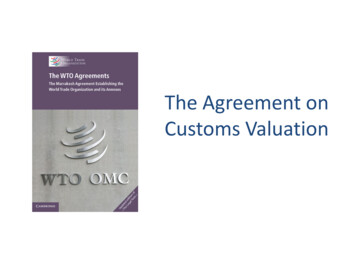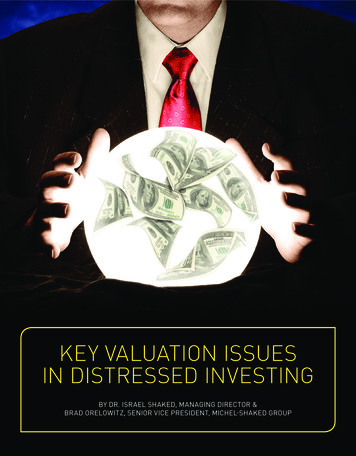
Transcription
KEY VALUATION ISSUESIN DISTRESSED INVESTINGBY DR. ISRAEL SHAKED, MANAGING DIRECTOR &BRAD ORELOWITZ, SENIOR VICE PRESIDENT, MICHEL-SHAKED GROUP
The distressed investor considersinvesting in securities ofcompanies that are either inbankruptcy or are approachingbankruptcy. Typically, thesecompanies have outstandingclaims greater than the value ofthe assets and are experiencingdifficulty in servicing their debt.There is a real possibility that thecompany will be liquidated or willbe reorganized as a going concern.The investor may be looking toacquire distressed debt or othersecurities in the hope that thesesecurities will either increasein value following a liquidationor reorganization, or convert toequity ownership. These twopossible outcomes, liquidationor reorganization, requiredifferent valuation methods tocalculate. However, there aremany uncertainties that theinvestor needs to consider.The definition of a distressedcompany varies. For example, someregard a company as distressed ifthe yield-to-maturity on its bonds ismore than 1,000 basis points greaterthan the risk-free rate. Other sourcesconsider companies rated at CCC orbelow as distressed. According toStandard & Poor’s, “[a]n obligationrated ‘CCC’ is currently vulnerable tononpayment and is dependent uponfavorable business, financial, andeconomic conditions for the obligorto meet its financial commitments onthe obligation. In the event of adversebusiness, financial, or economicconditions, the obligor is not likely tohave the capacity to meet its financialcommitments on the obligation.”Independent of the definition of adistressed investment, numerousvaluation implications exist.To approve the plan of reorganization,the Bankruptcy Court must beconvinced that post-reorganizationthe company is expected to be aviable, going concern entity, i.e.,the company is expected to operatein the foreseeable future. Thismay be performed by comparingthe value of the assets (commonlyreferred to as “business enterprisevalue”) of the company to its debts. Unfunded pension liabilitiesOne of the most basic methodsof valuing a company is to addup the book value of the assetsand subtract the book value of theliabilities. However, the result canbe highly misleading, as the assetswere recorded at their original cost,which may have no correlationwith the fair market value of thoseassets. For example, the value of theproperty, plant, and equipment maybe understated, as the replacementcost may be far higher than theoriginal cost. Furthermore, estimatesof depreciation would have reducedthe asset values on the balancesheet. Inventory, which is valuedat the lower of cost or market valuemay also not accurately reflectthe true worth of the asset. On theother side of the balance sheet,the book value of the liabilitiesfails to record off balance sheetliabilities that should be taken intoaccount when valuing a company. E conomywide factorsThe authors typically value a goingconcern entity based on an incomeor market approach and not onbook values. 1 The income approachlooks into the future at the cashflows expected to be generatedby the company and calculatesthe present value of these futurecash flows. The market approachcompares the value of comparablecompanies or comparable M&Atransactions to the subject company.Naturally, the valuation ofrelatively healthy companiesinvolves many unknowns anduncertainties, including: T he viability of thecompany’s product Relationships with vendors T he price of keyraw materials T he company’s futuremarket share Regulatory changesHowever, the valuation of distressedcompanies includes numerousadditional elements of uncertaintyas well. Examples include: T he ability to retain employees T he ability to reorganize T he structure of thereorganized entity T he ability to divestunderperforming assets L itigation risk resulting fromthe company’s distress Access to capital marketspost-reorganization C ost of fundspost-reorganization T he possibility that thecompany may be liquidatedThe uncertainty resulting from thedistress impacts all three commonlyused valuation methodologies.Several factors relating to thevaluation of distressed companiesas going concerns are discussedin the remainder of this article.Guideline PublicCompany MethodThis approach (also referred to asCompCo) determines a company’svalue based on selected multiplesof comparable publicly tradedcompanies. The authors identifycompanies that are in a similarbusiness to the subject company’sand compute multiples such asprice-earnings or enterprise valueto-EBITDA for these companies.These multiples are then multipliedby the subject company’s earningsor EBITDA to arrive at a value.continued on page 12Jan/Feb2017Journal ofCorporateRenewal11
Projections used in DCF analyses are inherently uncertain. For adistressed company, there is even more uncertainty. If the distressis due to industrywide issues, forecasting is even more difficult.continued from page 11Multiples may be calculated on historicalor projected results. Multiples basedon projected results are referred to asforward multiples. For a distressedcompany, historical results are lessrelevant than projected results,especially when the valuation assumesthat the company will be reorganized.However, when using forward multiplesof comparable companies, the investormust rely on uncertain projections. Also,analyst consensus estimates may not beavailable for the comparable companiesif they are not widely covered or ifthe analysts have stopped providingestimates because the comparablecompanies are also distressed.Often, a company may be distressedwhen the entire industry is also indistress. For example, during thefinancial crisis of 2008, many real estatedevelopers were in a similar state ofdistress. At the time, these developers’earnings and EBITDA were unusuallylow or negative. Multiples are calculatedwith earnings or EBITDA in thedenominator. Therefore, if these figuresare negative, the calculated multiplesare not meaningful. Similarly, if thesefigures are unusually low, the calculatedmultiples will be unusually high andalso may not be meaningful. In these2018 TMA EUROPEANNUAL CONFERENCE7-8 JUNE AMSTERDAM THE NETHERLANDSJan/Feb2018Journal ofCorporateRenewal12LE A RN MORE AT TM A-EUROPE .ORG
cases, it may be more meaningful tomove up the income statement andcalculate multiples based on revenue. 2Once calculated for the comparablecompanies, this multiple needs to beapplied to the subject company. Analysisis required to determine if the subjectcompany is a median (midrange,typical) company, or performs better orworse than the comparable companies.However, when the entire industry isdistressed, as real estate developerswere in 2008, such analysis is difficultto perform. One element not reflectedin the multiples is the expected growthrate. When companies are healthy andare expected to grow at a higher ratethan the industry as a whole, the authorsmay choose to use a multiple higherthan the median (e.g., upper quartile).For a distressed company, forwardmultiples carry a higher degreeof uncertainty. In addition, oftenthe return to profitability is notinstantaneous. If the turnaroundis expected to take a long time,forward multiples for the comparablecompanies may not be available.Many years ago, the authors workedon the bankruptcy of Hechinger, achain of home improvement storesheadquartered in Maryland. In thelate 1990s, its two largest competitors,Home Depot and Lowes, wereexpanding rapidly, with Home Depotalone spending more than 1 billionand opening more than 100 stores peryear. Many smaller competitors couldnot compete and were losing money.Selecting comparable companiesfor valuation was particularlychallenging, as Hechinger was notcomparable to Home Depot andLowes, and the smaller companieswere losing money, and thereforetheir multiples were negative andthus not economically meaningful.Guideline Merged andAcquired Company MethodThis methodology (also referredto as CompM&A) examines M&Atransactions. It determines a firm’svalue based on selected multiples ofcomparable target companies thatwere acquired in M&A transactions.The definition of fair market value isthe price at which the property wouldchange hands between a willing buyerand a willing seller, neither being underany compulsion to buy or sell andboth having reasonable knowledgeof relevant facts. If an industry isdistressed, M&A values may not reflectfair market values, as the selling partymight be under compulsion to sell.For example, the authors were askedto value a European sporting goodsmanufacturer that was involvedin litigation regarding its value atthe time of the sale of its business.The founder had died and his wifeinherited the company. She had nointerest in running the business.Moreover, she was concerned aboutthe value deteriorating due to herlack of knowledge of the business.She eventually sold the companyat a low value. In a dispute relatingto the value of this company, ajury decided that her compulsionto sell was a significant factor, andtherefore, the fair market value washigher than the transaction price.Discounted Cash Flow MethodThe discounted cash flow (DCF)valuation is a standard framework usedto value a business. It is a memberof a set of valuation methodologiesreferred to as the income approach.This process estimates a stream of cashflows into the future and then discountsthe stream by the discount rate backto the valuation date. A terminal valueis calculated, which accounts for theperiods extending beyond the timehorizon that was projected in detail.As mentioned earlier, the BankruptcyCourt will approve a plan ofreorganization only if the companyis expected to be a viable goingconcern. Projections used in DCFanalyses are inherently uncertain. Fora distressed company, there is evenmore uncertainty. If the distress is dueto industrywide issues, forecastingis even more difficult. The authorsoften find that management orfinancial advisors have projected arecovery post-reorganization. Thisrecovery usually follows a prolongedperiod of deterioration and mayresemble a hockey stick, whichoften attracts increased scrutiny.The projections require a number ofassumptions, the outcome of whichis highly uncertain. For example,one needs to consider whether therewill be any divestitures of businesssegments, headcount reductions,store closures, catch-up paymentsfor unfunded pension liabilities,reductions in capital expenditures, andmany more factors. An analysis of theprojections typically includes a test ofthe reasonableness of the assumptions.Once the cash flows have beendetermined, they are discounted tothe present value using a discountrate. The discount rate most frequentlyused to discount the debt-free cashflows is the weighted average cost ofcapital. As the name describes, this is aweighting of the costs of the differentsources of capital: debt and equity.The cost of debt is usually relativelysimple to determine in a healthycompany. For a distressed company,the cost of debt is usually high. Postreorganization, there is uncertainty as tothe cost of the restructured debt, whichis based on the uncertain amountof debt. To reduce the probability ofthe company filing for bankruptcyprotection a second time, BankruptcyCourts would only approve a reasonablelevel of debt that the company wouldbe able to service. Therefore, the cost ofdebt is often based on a non-distressedreorganized company post-emergencerather than the distressed companypre-Chapter 11. DIP financing shouldnot be used to determine the cost ofdebt, as DIP financing has a higherpriority over other classes of debt, whichtypically results in a lower cost of debt.The cost of equity is the returnnecessary to compensate investorsfor all of the risks associated withownership. The cost of equity iscalculated using the capital assetpricing model (CAPM). The CAPMincludes a measure of a company’ssystematic risk (referred to as “beta”),or tendency to move relative to themarket, and the risk-free rate. Thesystematic risk is determined using aregression between the rate of returnon the company’s stock and the returnon the overall market. However, giventhat a distressed company has its ownlife and thus is uncorrelated with themarket, the regression results maynot be meaningful, and thereforethe beta estimated during the periodof distress cannot be relied upon.Sometimes circumstances warrantadding a risk premium to the costof equity based on the size of thecompany, as empirical researchindicates that the required rate of returnby investors on small companies ishigher than on larger companies. Thedetermination of the size premium iscontinued on page 14Jan/Feb2018Journal ofCorporateRenewal13
continued from page 13complicated by the fact that investorsinvesting before a plan of reorganizationdo not know the size of the companypost-reorganization. The investor alsoneeds to carefully consider whetherit is appropriate to add a distresscomponent to the cost of equity,as post-emergence, the companyis not expected to be distressed.Included in the projections is anestimate for taxation. While the taxrate is usually known, the companymay have a large net operating loss(NOL). Under certain circumstances,NOLs can be carried back two yearsand carried forward 20 years to offsettaxable income incurred in those years.An assessment must be made as to howthe NOL will be used in the future. Asthe NOL provides a tax shield in thefuture, there is value to it. This valueis based on the amounts and timingof the tax savings that the companywill realize as a result of the NOL.The final component of the DCF isthe calculation of the terminal value.Once the company is projected toreach a steady state of cash flows, anassumption must be made as to therate at which these cash flows wouldcontinue to grow, in perpetuity. Asthe reorganized company may bearlittle resemblance to the distressedcompany, the determination ofthe growth rate is difficult.Judicial PreferenceWhile all three valuation methods arefrequently applied, many courts preferthe DCF method. For a reorganizedcompany, it is uncommon to valuethe company using only the guidelinepublic company approach or theguideline merged and acquiredcompany approach without alsoperforming a DCF. As discussed,however, all three valuationmethodologies have added challengeswhen applied to distressed companiesbeyond the issues ordinarily facedwhen valuing a healthy company. J1Jan/Feb2018Journal ofCorporateRenewal142 A n adjusted balance sheet approachmay be used where the value of assetsand liabilities are readily available. revenue is the top line of the incomeAsstatement, relying on it for calculatingmultiples has its own limitations.Dr. Israel Shaked is the managing director of TheMichel-Shaked Group and a professor of financeand economics at Boston University QuestromSchool of Business. Shaked has testified onnumerous valuation and bankruptcy cases. He canbe contacted at ishaked@michel-shaked.com.Brad Orelowitz, CPA, is a senior vice presidentof The Michel-Shaked Group and has morethan 25 years of experience in finance andaccounting. Orelowitz represents clients incomplex valuation and bankruptcy issues. He canbe contacted at borelowitz@michel-shaked.com.
used to discount the debt-free cash flows is the weighted average cost of capital. As the name describes, this is a weighting of the costs of the different sources of capital: debt and equity. The cost of debt is usually relatively simple to determine in a healthy company. For a distressed company,
